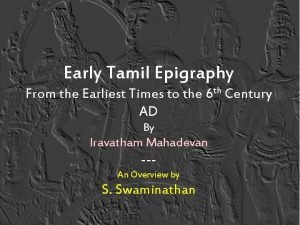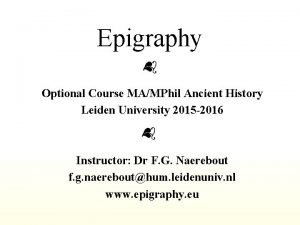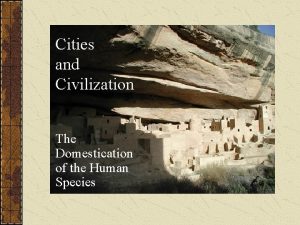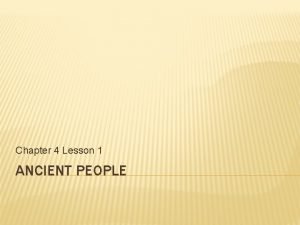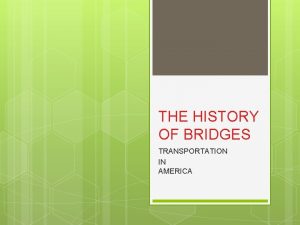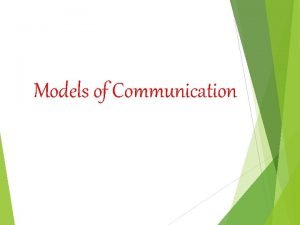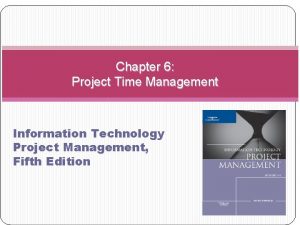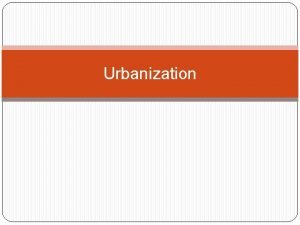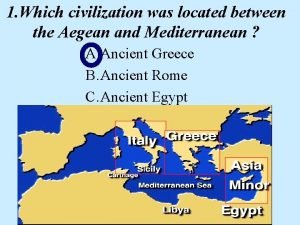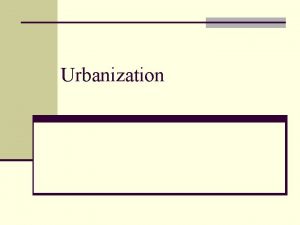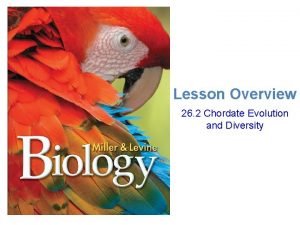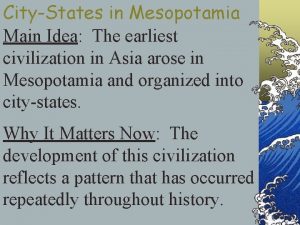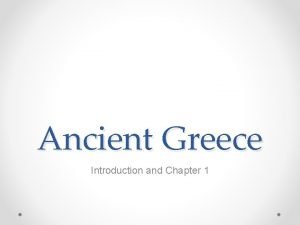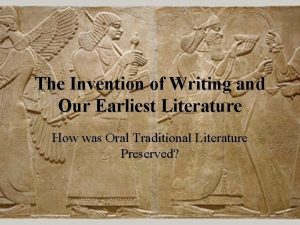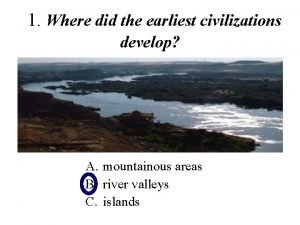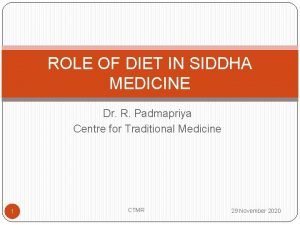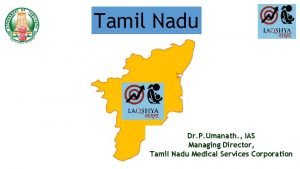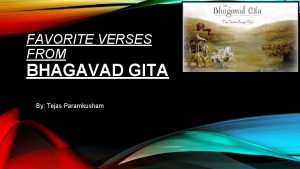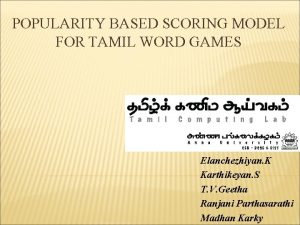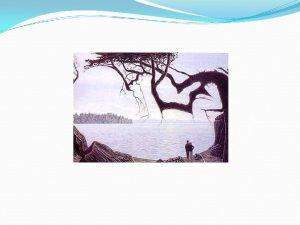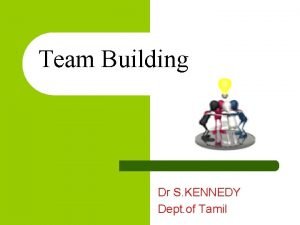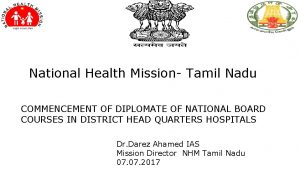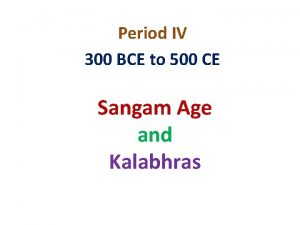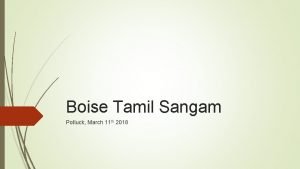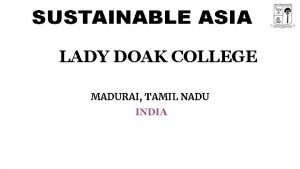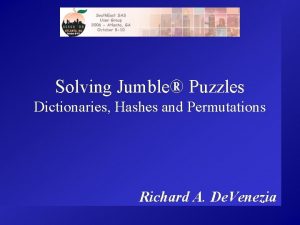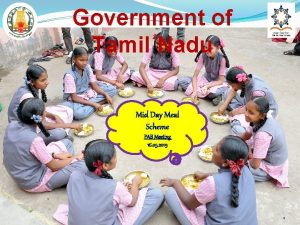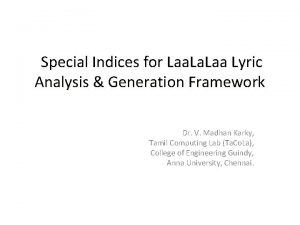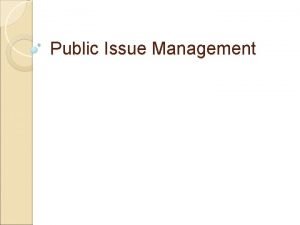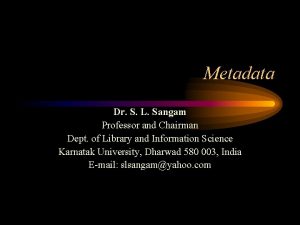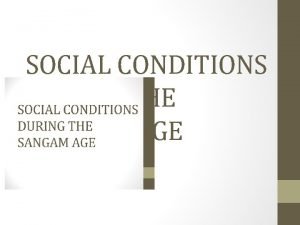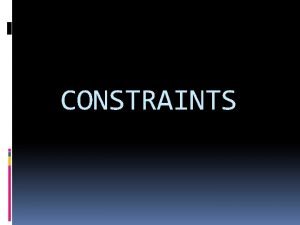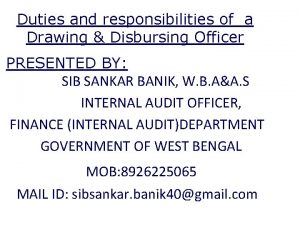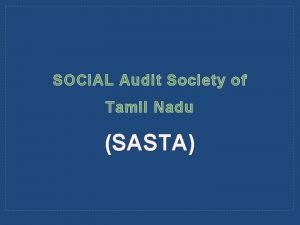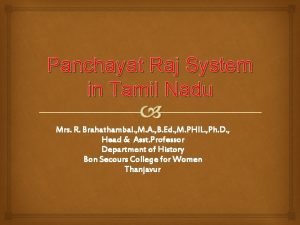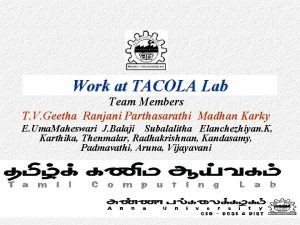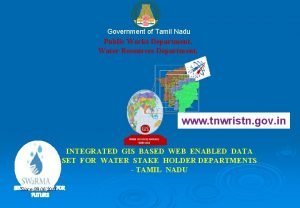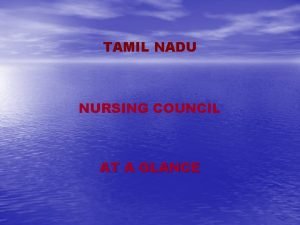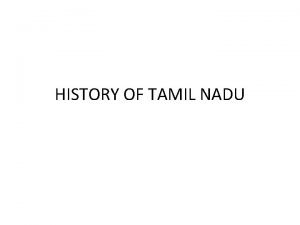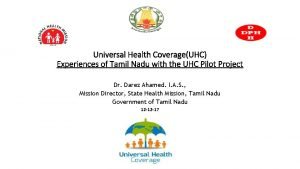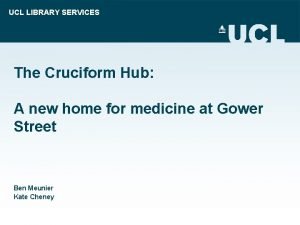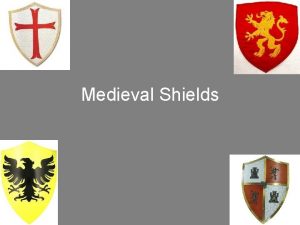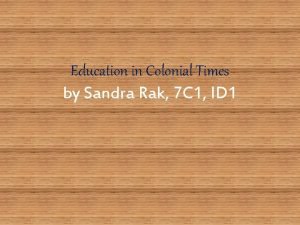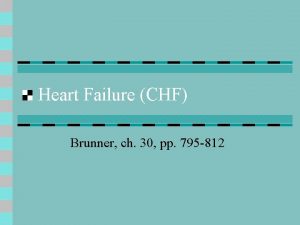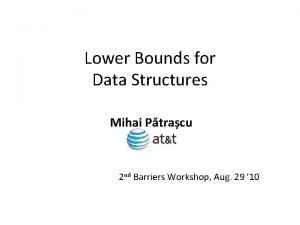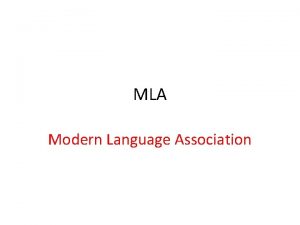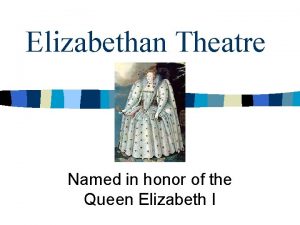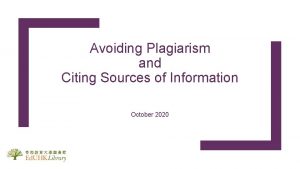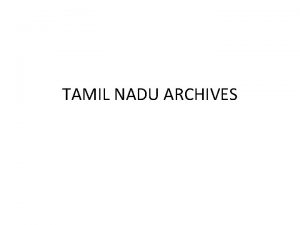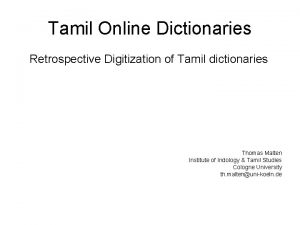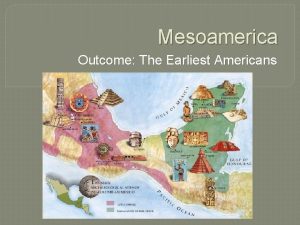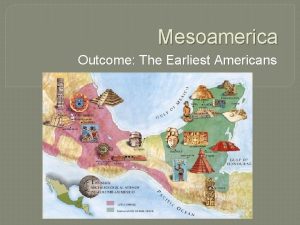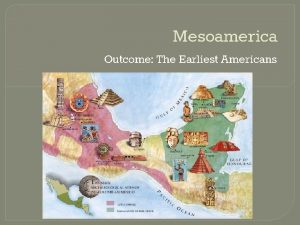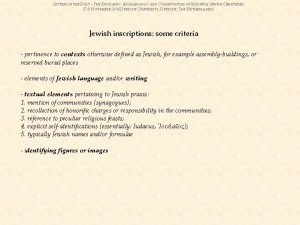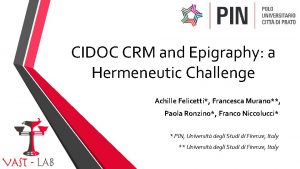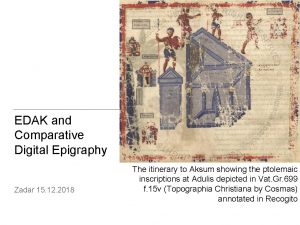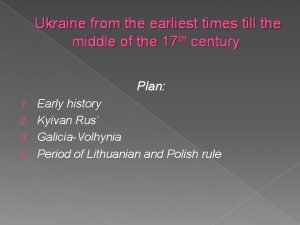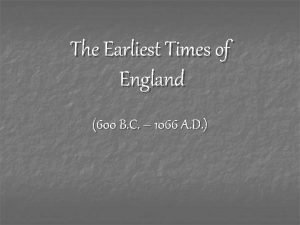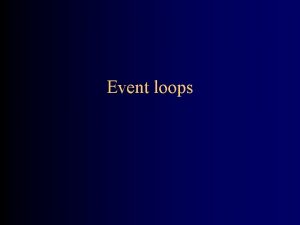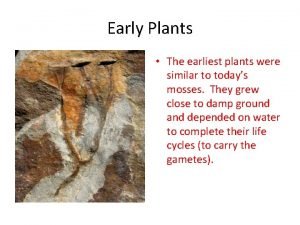Early Tamil Epigraphy From the Earliest Times to































































![Jamabai inscription According to Burrow the developments are: satiya [���� ] to atiya [����] Jamabai inscription According to Burrow the developments are: satiya [���� ] to atiya [����]](https://slidetodoc.com/presentation_image_h/2e2a25ee6fd17fdbe4575df9be6a5250/image-64.jpg)













































![Mahadevan’s findings Origin of Tamil-Brahmi Tolkappiyam places the four letters zh [�], L [� Mahadevan’s findings Origin of Tamil-Brahmi Tolkappiyam places the four letters zh [�], L [�](https://slidetodoc.com/presentation_image_h/2e2a25ee6fd17fdbe4575df9be6a5250/image-110.jpg)













- Slides: 123

Early Tamil Epigraphy From the Earliest Times to the 6 th Century AD By Iravatham Mahadevan --An Overview by S. Swaminathan

Early Tamil Epigraphy From the Earliest Times to the 6 th Century AD By Iravatham Mahadevan --Published by Cre-A, India & Harvard University, USA 2003

The book deals with development of two scripts of Tamil: Tamil-Brahmi and Early Va. TTezhuttu covering a period from the 3 rd century BC till the 6 th century AD.

First, let me provide some background information regarding the scripts discussed in the book in order to follow ‘My Overview’

We would come across with five scripts in the book: Brahmi, Tamil Brahmi, Va. TTezhuttu, Tamil and Grantha Short description of these scripts follows.

Brahmi is an ancient script of India. The earliest writing in Brahmi is found in the edicts of Asoka dated to the 3 rd century BC. Brahmi is a general term and there existed a number of regional variations, like Southern Brahmi, Sinhala-Brahmi etc.

Brahmi Mother script of Indian Languages Brahmi is the script from which all other native Indian scripts, except the Harappan, are derived.

Development of the letter N (� ) in all Indian languages starting from Brahmi, It may be noted how the characters change drastically over the centuries!

Development of latter k (�) in Devanagari, Tamil and other south Indian Scripts BC-AD

Development of vowels of Tamil from Early Tamil-Brahmi

Development of consonants of Tamil from Early Tamil-Brahmi

Brahmi Mother script of many Asian Languages Pallava Grantha, a derivative of Brahmi, a script developed to write Sanskrit in the Tamil country was the inspiration to most of the Asian scripts. This happened through the political and the cultural conquest by the Indian rulers starting from the Pallava-s

Development of letter k (�) for the languages of Java, Sumatra Borneo, Thai, Laos, Khmer, Combodia, Vietnam, etc from the Grantha script

Tamil-Brahmi is the name of the script in which the earliest inscriptions in Tamil are found. Let us see how Tamil-Brahmi looks like

Tamil-Brahmi inscription Kudumiyanmalai, 3 rd century AD �� � û ��� ü � ó � ö �[�� ] ö The hermitage (is the gift) of ko. RRantai of n. Azha. L

Va. TTezhuttu, a cursive style, was derived from Tamil-Brahmi, and was current all over the Tamil country from the 5 th century AD.

Va. TTezhuttu Tamil script that came into use from the 7 th century displaced Va. TTezhuttu. With the ascendancy of the Chozhas, and the displacement was total by 13 th century. However the script lingered on till the 19 th century in Kerala for writing Malayalam.

Va. TTezhuttu The Pulankurichchi inscriptions (5 th century) are the earliest. A number of hero-stones in the Dharmapuri district have been found inscribed in Early Va. TTezhuttu. Let us see a specimen of Va. TTEzhttu

Vattezhuttu inscription Thirunatharkunru, 6 th century AD � ������� � � ai m pa t t. E zha na �� ����� �� � ca na n n. O R Ra � ���� � ca na ti ra na n ti A ����� �� ������� � �� �� §¿¡ýÒ ������ ci ri ka ru ni c. I ti kai ����� � ������� ���� The seat of penance of chantiramanti Acirikaru, who observed the fast (unto death) for fifty-seven days

Tamil Script The Pallava rulers created the Tamil script out of the Grantha script by the 7 th century, adding necessary additional letters from Va. TTezhuttu. This is the view of Mahadevan, and is not shared by some.

Tamil Script There are (according to Mahadevan) no inscriptions in the Tamil script before Mahendra Pallavan I (7 th century AD).

Tamil Script There was a steep increase in inscriptions in Tamil from the 9 th century onwards. The classical phase of Tamil script starts with the ascendancy of the Chozha-s from the middle of the 9 th century. From the 11 th century onwards this became the main script for Tamil throughout the Tamil country. Here is an example of Tamil script in the early stages

Tamil inscription Parantaka Chozha, 10 th century AD Š� Š��‚ ��� ô������ � �÷� svati. Shr. I k. Opparak. Esari parma ÷Ì �� ñÎ 34 ��� ñÎ ��� Rku y. ANdu 34 iv. ANDu k. Ana �� ðÎ Ó��� ó�� ì Ì�òÐ n. ATTu muniyantaik ku. Lattu ìÌ �ó��� � � î�ý ã÷ò�� � ðÊ Kku manthiri Accan m. Urti a. TTi � �� Í 2 ��ñÎ ���� �Õ ���� ø Na k. Acu 2 ira. NDu k. Ac. A oru k. Ac. Al In the 34 th year of Parantaka Chozha, Achchan m. Urti, a minister, has given 2 kasu-s for the renovation of the lake

Grantha Script Grantha, was derived from the Southern Brahmi script of Prakrit characters by the Pallava-s (6 th century AD) to write Sanskrit in the Tamil country. Let us see how Grantha script then looked like.

Grantha inscription Mahendra Pallava, 7 th century AD ²¾¾ 3É¢‰¼Áò 3ÕÁÁ§Ä¡ Etadanish. Tamadrumamal. O †Á…¤¾ 4õ Å¢º¢òú¢ò§¾¿ Hamasudham vicitracitt. Ena ¿¢÷Á¡À¢¾óÕ§À½ô 3˧Á nirm. Apitan. Rp. RNabrahm. E ‰ÅÃÅ¢‰ÏÄì„¢¾¡ ¾¿õ Shvaravish. Nulakshit. Ayatanam The (cave) temple dedicated to Brahma, Siva and Vishnu was excavated by Vichitrachitta (Mahendra Pallava) without using brick, timber, metal and mortar.

Discovery of inscriptions in the Tamil country has been eventful

Discovery Till the end of the 19 th century only two scripts were known: Va. TTezhuttu of the Pandiya-s belonging to 8 th century and Tamil of the Pallava-s dated the 7 th century It was wondered why there should be two scripts for one language. But their descent from Brahmi was inferred.

Discovery The complete absence of written record of a great literary civilization of 2000 years vintage was a puzzle.

Discovery This was solved when cave inscriptions, resembling closely the script of Asokan edicts, were found in Tamilnadu around the end of the 19 th century.

Discovery The earliest finding of cave inscription is of Mangulam by Robert Sewell in 1882. This is not only oldest finding, it is oldest lithic record in Tamilnadu and it is also of great historical significance. And a host of discoveries followed.

Discovery Until middle of the last century cave inscriptions were the only source of early Tamil writing. Then it was presumed that Tamil-Brahmi inscriptions were caused to be inscribed by Jaina and Buddhist monks who were not conversant with Tamil, and that these inscriptions did not represent language of the day.

Discovery With the finding of inscribed pottery in Arikkamedu during 1941 -44 and later from many other sites the view has changed.

Discovery The pottery inscriptions made it possible to date inscriptions more accurately. It looks that inscribing on pottery was given up after the 3 rd century AD.

Deciphering, the Tamil-Brahmi script

Deciphering Difficulties Deciphering cave inscriptions posed a number of problems: Most of the inscriptions were in inaccessible locations Inscriptions were not bold and clear Language was mistaken for Prakrit Clues to a correct understanding of the script were not found.

Deciphering Milestones 1906: Venkayya identified the script to be Brahmi. But he thought that the language was Pali. He read a line in Mettuppatti as anatai ariya, attempted to seek Vedic roots for the words. 1914: Krishna Sastri attempted to read the bold Sittannavasal inscription.

Deciphering Milestones 1919: Krishna Sastri first noted purely southern charactaristics, like the occurrences of letter L [� ] which was identified earlier in Simhala-Brahmi. He also identified the presence of three unusual characters, later identified as zh [�], R [�] and n [� ]. He was the first to feel that some of the consonants must be basic (� �ö).

Deciphering Milestones 1924: KV Subramania Iyer pointed out the powerful misguiding factor that was written in Brahmi must be in Prakrit.

Deciphering Milestones 1924: KV Subramania Iyer found: - Soft consonants (ग ज ड द ब) were absent - sa (� , �) was occasionally used; but Sh (º, श) and sh (� , ष) were absent. - All vowels except ai , au, Ri (ऋ), Lr (ऌ), M (अ ) and H (अ ) were used - Conjunct consonants (Üð�� ØòÐ) were absent completely

Deciphering Milestones 1924: KV Subramania Iyer ruled out Indo-European language and proved it is Tamil. He demonstrated convincingly presence of Tamil grammatical elements like p. Akan (À¡¸ý), va. Nikan (Ž¢¸ý), etc

Deciphering Milestones 1924: KV Subramania Iyer could not still read correctly because of his incorrect orthography (spelling), his overestimation of the Prakrit elements, etc

Deciphering Milestones 1938 -9: Narayana Rao tried to put the clock back. He felt that the language was Prakrit, and actually read the inscriptions fully!

Deciphering Milestones 1961: KG Krishnan identified pulli (ÒûÇ�), a device introduced ‘later’ to mark the basic consonants (� �ö ±ØòÐ) and the short e (±) and o (´) vowels. Later pulli was also identified in the 2 nd century AD silver coin of Satakarni.

Deciphering Milestones 1964: Kamil Zwelebil published the first formal study of cave inscriptions. 1967: TV Mahalingam published the first book-length study of cave inscriptions.

Deciphering Mahadevan’s attempts 1961: Mahadevan took up study of inscriptions 1962 -66: First round of visits to the caves 1966: Corpus of 74 Tamil-Brahmi inscriptions and 2 Early Va. TTezhuttu inscriptions from 21 sites published 1987: Mahadevan proposed a tentative model 1991 -96: Second field expedition 2003: Publication of ‘Early Tamil Epigraphy’

Deciphering Mahadevan’s attempts Mahadevan made field visits to the sites and prepared tracings direct from stones and made use of computer enhancement of photos. He made chronological classification.

Let us have a look at some important inscriptions

Mangulam inscription was discovered by Robert Sewell in 1882, and was rediscovered by KV Subramania Iyer in 1906

Mangulam inscription This Tamil-Brahmi inscription is important, because this is the earliest inscription to be found and in this inscription Nedunchezhiyan, a Sangam king, is mentioned.

Mangulam inscription

Mangulam inscription The inscription is in Tamil-Brahmi and is dated to the 2 nd century BC

Mangulam inscription A line from the inscription is given to compare the Tamil script 2000 years ago with the present day script. � �� ka Ni �� � � �� � y na n ta a si ri y i It may be noted that a non-Tamil letter s (� ) is used

Mangulam inscription The text of the inscription is given along with meaning in present day Tamil ������������� � � 3������ � ka. Niy nanta’asiriy’I kuv’ank. E dammam itt. A’a ne. Tuncazhiyan ������������� � pa. Na’an ka. Dal’an vazhuttiy ko. Tuppitta’a pa. Liy ������� � ��� ; ������� � ���� � �������� This is the charity to nanta-siri kuvan, the ka. Ni; the bed was caused to be carved by ka. Talan vazhuti, the servant of ne. Tunchezhian.

Edakkal inscription Inscription in Edakkal, Kerala was discovered by Fawcett in 1894. He made careful drawing and took photos and submitted to Hultzsch took estampages and published a brief note to Fawcett published a paper in 1901. Hultzsch made an attempt to decipher, but could not. For a century no further was action taken

Edakkal inscription Mahadevan made two expeditions in 1995 and 1996. Unfortunately, these Tamil-Brahmi inscriptions have been obliterated due to graffiti by tourists

Edakkal inscription During the 1996 expedition, Mahadevan found two other Tamil-Brahmi inscriptions dated to the 3 rd century AD. In one of them there was a mention of ka. Tummiputa ch. Era, a Ch. Era king. This is also another important inscription for it belongs to the age of a Sangam king

Pugalur inscription In Pugalur, near Karur, the ancient Chera capital a number of inscriptions were discovered. One of them is important for it is a record of a Chera king of the Irumporai line which ruled from Karur in the Sangam age.

Pugalur inscription The text of the inscription Ó�� �� ñ� ý �� üê÷ �� í���� ý ��� mut. A ama. NNan y. ARRUr senk. Ayapan u. Raiy ��� �� ý �� ø�� Õõ���� � ��ý k. O Atan cellirumpo. Rai makan �� Õí�Îí��� ý ��ý{� }� í perunka. Tunk. On makan (i)Lan �Îí��� {� }� í��� �� � Úò� �ø ka. Tunk. O(i)Lank. O Aka a. Rutta kal ö

Pugalur inscription The meaning of the inscription The abode of the senior Jaina monk, senk. Ayapan of y. ARRUr. The rock (shelter) was carved when (i)Lanka. Tunk. O, the son of perunka. Tunk. On, the son of King Atan sel irumpo. Rai, became the heir apparent.

Jamabai inscription Inscription in Jambai, in Villuppuram district, is one among the most outstanding discoveries. Dated to the 1 st century AD the inscription records the grant of a cave shelter by atiyan ne. Tum. An anchi, identified as the famous chieftain of Takatur (modern Dharmapuri), celebrated in Purananuru.

Jamabai inscription The text of the inscription is given along with its meaning ���� Ò��� ����ó �� Î�� ó � ï�� �ò� �Ç� satiyaput. O atiyan ne. Tum. An anci Itta pa. Li The hermitage was given by atiyama. An ne. Tum. An añchi, the satiyaputta

Jamabai inscription Atiyan ne. Tum. An anchi, has the title of satiyapit. O; a title found in the Second Rock edict of Asoka along with Cheras, Chozhas and Pandyas, thus establishing conclusively Asoka’s connection with the Tamil country.

Jamabai inscription The identification of Satiyaputo with Atiyaman was on the linguistic grounds by Sesha Iyer and improved upon by Burrow.
![Jamabai inscription According to Burrow the developments are satiya to atiya Jamabai inscription According to Burrow the developments are: satiya [���� ] to atiya [����]](https://slidetodoc.com/presentation_image_h/2e2a25ee6fd17fdbe4575df9be6a5250/image-64.jpg)
Jamabai inscription According to Burrow the developments are: satiya [���� ] to atiya [����] (with the loss of the initial consonant), and put. O [Ò��� ] meaning ‘son’ [makan, ��ý] then makan [��ý] to m. An [�� ý] like ch. Eram. An [� ºÃÁ� ý] corresponding to k. Era. Laput. O [�� ÃÇÒ��� ].

Now let us go through the contents of the book

Mahadevan’s Book Mahadevan’s book deals with Early Tamil-Brahmi (2 nd century BC to 1 st century AD) Late Tamil Brahmi (2 nd to 4 th centuries AD) Early Vattezhuththu (5 th & 6 th centuries AD) and does not include Later Vattezhuththu and Tamil (both from 7 th century AD)

Mahadevan’s Book Contents Part One: Early Tamil Inscriptions Part Two: Studies in Early Tamil Epigraphy Part Three: Corpus of Early Tamil Inscriptions

Part One Early Tamil Inscriptions

Chapter 1 Discovery Discovering cave inscriptions have been uneven and the book discusses important discoveries. The contemporary inscriptions on potteries, coins, seals and rings are included in the appendix to this chapter.

Chapter 2 Decipherment The exciting story of deciphering is a very important chapter. The early attempts like the path-breaking paper by KV Subramania Iyer in 1924, and the discovery of pulli, and important researches from 1970, including Mahadevan’s work, and finally, a chronology of Tamil-Brahmi inscriptions that includes pottery and other inscriptions.

Chapter 3 Language This chapter discusses the unsolved problem of the language of the cave inscriptions: how much and what kind of Tamil, explains the Dravidian and Indo-Aryan elements

Chapter 4 Polity The chapter shows how cave inscriptions portray life in early Tamil society: state and administration; religion, particularly Jainism; society – agriculture, trade, professions, social organisations, personal names, place names, flora & fauna and culture

Chapter 5 Palaeography (Study of ancient writing) Review of earlier theories, listing evidences to support his theory of origin of Tamil-Brahmi from Brahmi supported by 8 palaeographic Charts Brief discussion on other Brahmi variants.

Chapter 5 Palaeography (Study of ancient writing) Detailed discussion on palaeography of Tamil-Brahmi and early Va. TTezhuttu: vowels, consonants, the pulli, numerals punctuation, symbols used in caves Short discussion on evolution of Va. TTezhuttu Notes on emergence of Tamil script

Chapter 6 Orthography (Study of spelling) The most important chapter. Different orthographic models studied, especially for denoting medial vowels, which among other things, provides insight into the relationship of Tamil-Brahmi and other Brahmi variants and their relative chronology

Chapter 6 Orthography (Study of spelling) Orthographic peculiarities of inscriptions Evolution of alternate models: Tamil-Brahmi I, II and III Medial vowel notations in cave and pottery inscriptions Assimilation of loan-words Voicing of consonants

Chapter 7 Grammar Phonology (study of sounds) with detailed inventory of vowels, consonants and consonant-vowels and sound variations, Morphophonemics, study of changes that occur, during Sandhi etc, Morphology (study of forms of changes of words) in early Tamil and Syntax (arrangement of words in a sentence)

Part Two Corpus of Early Tamil Inscriptions

Corpus of Early Tamil Inscriptions Contents Inscriptions Early and late Tamil-Brahmi Early vattazhuttu Tracings and estampages Commentary

Corpus of Early Tamil Inscriptions 110 inscriptions from 52 sites arranged chronologically, with text containing Literal transcript as engraved on stone, Text organised into words, Translation into English, Essential data specific to individual inscriptions, Date, Publication and most importantly, Notes This is an authoritative Corpus for researchers.

Part Three Corpus of Early Tamil Inscriptions Commentary on Inscriptions

Commentary on Inscriptions A detailed word-by-word study of inscriptions, with a view to situate them in the main stream of Indian epigraphy: deals with Meaning, literal and interpretation Grammatical notes Citations from literary and inscriptional parallels Loan words Contents, relating to the development of Tamil language and society

Let us follow some important discussions

Different Requirements of Prakrit and Tamil Many Asokan edicts are in Prakrit and the script is Brahmi. This Brahmi script cannot be used directly for Tamil, because there are no symbols to represent basic consonants and short e and o

Attempts to adapt Brahmi for Tamil At least three different methods Tamil-Brahmi I, II and III were tried for medial vowel notation, that is, to represent basic consonants like (ì), consonants with medial –a, like (¸) and –A, like (¸� ).

Pulli in Tamil-Brahmi Pulli came to be used in Tamil-Brahmi later as a negative vowel marker to provide what the parent Brahmi script lacked. to represent basic consonants (ì), and to represent short e (±) and o (´).

Pulli in Tamil-Brahmi Pulli occurs only from the 2 nd century AD onwards But it is seldom found in the pottery inscriptions. Even later, it was avoided in palm leaf writing

A short summary of Mahadevan’s findings

Mahadevan’s findings Stages of Development According to Mahadevan there were three stages of development of medial vowel notation Tamil-Brahmi I - 2 nd century BC to 1 st century BC Tamil-Brahmi II - 1 st century BC to 5 th century AD Tamil-Brahmi III - 2 nd century AD to 6 th century AD

Mahadevan’s findings Stages of Development The figure that follows attempts to show, through an example, the basic consonants and medial vowel notations as depicted in these stages. Possible ambiguity is indicated by pointing out alternate readings.

Mahadevan’s findings Stages of Development º� �� cannot write ���ó ��� ó Alternate readings ��ó ���ó ���� ó Alternate readings �� ò� �� òó ���� ó No alternate reading

Mahadevan’s findings Stages of Development In the light of finding TB-II style of writing in the Arikamedu potteries dated to 2 nd century BC, Mahadevan is expresses his inability to explain how ‘two parallel, mutually exclusive, competing systems’ appear at the same time, and within a small, homogenous linguistic community’.

Mahadevan’s findings Stages of Development Since most of the Early Brahmi inscriptions are found near Madurai, Tamil-Brahmi script must have been created in the Pandya kingdom around the end of 3 rd century BC, and then spread to other parts of the Tamil country

Mahadevan’s findings Language The language is Old Tamil, not materially different from the language of later Tamil inscriptions or even literary texts, in its basic phonological, morphological and syntactical features.

Mahadevan’s findings Language All loan-words are nouns. Most of the loan-words are adapted to the Tamil phonetic pattern: ga. Naka to ka. Naka g. Opa to k. Opan r. Aj. A to ir. Asar d. Anam to t. Anam adhi. TTh. Ana to ati. TTAnam

Mahadevan’s findings Comparison with Situation in Upper South India The earliest Tamil inscriptions are from 3 rd century BC, whereas of Kannada-Telugu appear 8 centuries later. Sangam literature is dated to the beginning of Christian era while literature of Kannada and Telugu appear a millennium later.

Mahadevan’s findings Comparison with Situation in Upper South India The earliest inscriptions in the Tamil country are almost exclusively in Tamil. In contrast, for the same period, inscriptions in stone, seals, pottery etc, in the Upper South India are exclusively in Prakrit.

Mahadevan’s findings Widespread literacy in Tamilnadu Literacy in the Tamil country when compared with the situation in contemporary Upper South India, commenced much earlier. Tamil, the local language, was used for all purposes from the beginning; democratic character in society existed.

Mahadevan’s findings Widespread literacy in Tamilnadu Literacy in the Tamil Country seems to have been widespread in all the regions in the Tamil country, both in urban and rural areas, in all strata of Tamil society. Primary evidence for this comes from inscribed pottery.

Mahadevan’s findings Widespread literacy in Tamilnadu A number of reasons are contributed to this: In Upper South India the spoken languages were Kannada and Telugu, but Prakrit was the language of the rulers. But the Tamil country was politically independent and the rulers were Tamils.

Mahadevan’s findings Widespread literacy in Tamilnadu It had the presence of a strong bardic tradition Priestly hierarchy that could have vested interest in maintaining oral tradition or discouraging writing after its advent was not present

Mahadevan’s findings Widespread literacy in Tamilnadu A strong tradition of local autonomy, through self-governing villages councils and merchant guilds. The spread of Jainism and Buddhism and extensive foreign trade.

Mahadevan’s findings Origin of Tamil-Brahmi was derived from Brahmi: All but 4 of the 26 letters in Tamil-Brahmi are identical or nearly so with the corresponding Brahmi letter and have the same phonetic value.

Vowels Brahmi Tamil-Brahmi

Consonants Brahmi Tamil-Brahmi

Medial vowel signs are identical along with phonetic values. Brahmi Tamil-Brahmi

Development of additional letters The additional letters, zh, � L, � R � and n � were adapted from letters with the nearest phonetic value in Brahmi.

Development of additional letters � � � �

Mahadevan’s findings Evolution and Chronology of South Indian Scripts 3 rd century BC 2 nd century BC 1 st century BC 5 th century AD 6 th century AD 7 th century AD 14 th century AD
![Mahadevans findings Origin of TamilBrahmi Tolkappiyam places the four letters zh L Mahadevan’s findings Origin of Tamil-Brahmi Tolkappiyam places the four letters zh [�], L [�](https://slidetodoc.com/presentation_image_h/2e2a25ee6fd17fdbe4575df9be6a5250/image-110.jpg)
Mahadevan’s findings Origin of Tamil-Brahmi Tolkappiyam places the four letters zh [�], L [� ], R [�] and n [� ] at the end of the series of stops, nasals and liquids. This arrangement deviates from the order based on articulatory phonetics. This small, but significant detail, indicates that the four special letters were originally regarded as additions to the alphabet taken from Brahmi.

Possible issues for discussion in the future

Issues Which came first – Brahmi or Tamil-Brahmi? Mu Va (1972) says that the Tamils used a script of their own, and Tamil-Brahmi has developed under the influence of Va. TTezhuttu. TN Subramanian (1957), KG Krishnan (1981) and a few others argue that Brahmi was a Tamil creation, and came to be adapted all over India with regional modifications. Mahadevan says Tamil-Brahmi is a derivative of Brahmi.

Issues Was there a script for Tamil before? Mayilai Seeni Venkatasamy (1981) says that there was one in which classical works were written and was supplanted by Tamil-Brahmi. Mahadevan says that Tamil was not written before.

Issues What kind of Tamil? Mayilai Seeni Venkatasamy (1981) says the inscriptions are full of errors engraved by people with inadequate knowledge of Tamil. Mahadevan says it is Old Tamil, not very different from contemporary literary Tamil.

Issues Dating Tolkappiyam Mahadevan says that Tolkappiyam must have been composed not earlier than 2 nd century AD for it describes the use of pu. LLi to denote basic consonants, and to denote short vowels e and o

Issues Voicing in Tamil Today we write murukan and read it as murugan k is called unvoiced and g as voiced. The present use follows Caldwell law of convertibility: It is K in the beginning (Ka. N) and when doubled (makka. L), and it is G when it occurs in the middle (murugan) or follows the nasal consonant (mangai) There has been controversy whether in the past also it was so in the past too.

Issues Voicing in Tamil One view is: Voicing existed from the beginning from the pre-Tamil stage. It is present in all Dravidian languages. Hence must have existed in early Tamil also but not provided for in the spelling. Originators were aware of the principle of phoneme, and did not feel necessary to borrow voiced consonants from Brahmi.

Issues Voicing in Tamil Mahadevan says There was no voicing in Tamil, in early Tamil. If voicing was present the adaptors of the script for Tamil from Brahmi would have borrowed the corresponding letter.

Issues Voicing in Tamil Mahadevan continues: Even in the loanwords from Prakrit voicing has been systematically replaced by the corresponding unvoiced consonants like, ka. Ni (PKT: gani), utayana (PKT: udayana), nanta (PKT: nanda), ki. Tumpikan (PKT: ku. Tumbika) etc.

Issues Voicing in Tamil Mahadevan continues: There is negative evidence in Tolkappiyam, which devotes a whole chapter to articulatory phonetics (±Øò�������õ - ���ô���ø) would have dealt with voicing if the feature was present in the language.

Mahadevan does not discuss The origin of Brahmi. His research on the Indus script and the possibility of Brahmi originating from it. Effect of writing medium and tools on the development of scripts. Reason for the disappearance of Va. TTezhuttu.

Now the stage is set for a serious study of the development of Tamil scripts.

Thank you S. Swaminathan
 Tamil epigraphy
Tamil epigraphy What is epigraphy? *
What is epigraphy? * Mat0022
Mat0022 Early cpr and early defibrillation can: *
Early cpr and early defibrillation can: * Earliest urban hearths
Earliest urban hearths The earliest texans lived in shelters made of wood.
The earliest texans lived in shelters made of wood. It is the recorded activities during early civilization
It is the recorded activities during early civilization Earliest form of tennis was called
Earliest form of tennis was called The earliest bridges consisted mainly of
The earliest bridges consisted mainly of Advantages of shannon weaver model of communication
Advantages of shannon weaver model of communication Earliest start time formula
Earliest start time formula The earliest start time rule
The earliest start time rule Urban hearths
Urban hearths The earliest fossils date back to about when?
The earliest fossils date back to about when? Heroes
Heroes Earliest comedian
Earliest comedian What is the first sad memory of the young jose
What is the first sad memory of the young jose The earliest aegean civilization was located
The earliest aegean civilization was located Socio-cultural impacts
Socio-cultural impacts Earliest earth
Earliest earth Earliest chordates
Earliest chordates The earliest civilization in asia arose in
The earliest civilization in asia arose in The earliest known grecian epics were written by____ .
The earliest known grecian epics were written by____ . The are our earliest literature
The are our earliest literature Where did the earliest civilizations develop
Where did the earliest civilizations develop Thuringi manapagu
Thuringi manapagu Love all serve all
Love all serve all Smart grid meaning in tamil
Smart grid meaning in tamil Dr umanath ias
Dr umanath ias Ajnana timirandhasya shloka
Ajnana timirandhasya shloka Elanchezhiyan meaning in tamil
Elanchezhiyan meaning in tamil Group discussion in tamil
Group discussion in tamil For women
For women Nhm tamilnadu
Nhm tamilnadu Kongu region
Kongu region Tejiwala meaning in tamil
Tejiwala meaning in tamil Potluck meaning in tamil
Potluck meaning in tamil Sdg 11
Sdg 11 Circled letters font
Circled letters font Kalviamuthu blogspot com
Kalviamuthu blogspot com Financial management in tamil
Financial management in tamil Noon meal forms 2019-20
Noon meal forms 2019-20 Edhugai monai
Edhugai monai What do you mean by public issue management
What do you mean by public issue management Sangam mulmi
Sangam mulmi Female anatomy outside
Female anatomy outside California tamil academy books
California tamil academy books Time bound promotion for doctors in tamilnadu
Time bound promotion for doctors in tamilnadu Keva silver plus benefits in hindi
Keva silver plus benefits in hindi Social life of sangam age
Social life of sangam age Scleronomic meaning in tamil
Scleronomic meaning in tamil Drawing and disbursing
Drawing and disbursing Mgnrega social audit tamil nadu
Mgnrega social audit tamil nadu Balwant rai mehta committee
Balwant rai mehta committee Ranjani meaning in tamil
Ranjani meaning in tamil Tamil nadu public works department
Tamil nadu public works department Chief minister special cell meaning in tamil
Chief minister special cell meaning in tamil Ciri sekolah vernakular
Ciri sekolah vernakular Tamilnadu nursing council
Tamilnadu nursing council Meaning of sangam in history
Meaning of sangam in history Universal health coverage in tamil
Universal health coverage in tamil Amazon open delivery
Amazon open delivery Urban horticulture
Urban horticulture Dare to fail meaning in hindi
Dare to fail meaning in hindi Chúa yêu trần thế alleluia
Chúa yêu trần thế alleluia Khi nào hổ con có thể sống độc lập
Khi nào hổ con có thể sống độc lập Diễn thế sinh thái là
Diễn thế sinh thái là Vẽ hình chiếu vuông góc của vật thể sau
Vẽ hình chiếu vuông góc của vật thể sau Cong thức tính động năng
Cong thức tính động năng Phép trừ bù
Phép trừ bù Tỉ lệ cơ thể trẻ em
Tỉ lệ cơ thể trẻ em Lời thề hippocrates
Lời thề hippocrates Vẽ hình chiếu đứng bằng cạnh của vật thể
Vẽ hình chiếu đứng bằng cạnh của vật thể đại từ thay thế
đại từ thay thế Quá trình desamine hóa có thể tạo ra
Quá trình desamine hóa có thể tạo ra Kể tên các môn thể thao
Kể tên các môn thể thao Hình ảnh bộ gõ cơ thể búng tay
Hình ảnh bộ gõ cơ thể búng tay Khi nào hổ mẹ dạy hổ con săn mồi
Khi nào hổ mẹ dạy hổ con săn mồi Thế nào là mạng điện lắp đặt kiểu nổi
Thế nào là mạng điện lắp đặt kiểu nổi Dạng đột biến một nhiễm là
Dạng đột biến một nhiễm là Biện pháp chống mỏi cơ
Biện pháp chống mỏi cơ Phản ứng thế ankan
Phản ứng thế ankan Chó sói
Chó sói Thiếu nhi thế giới liên hoan
Thiếu nhi thế giới liên hoan điện thế nghỉ
điện thế nghỉ Vẽ hình chiếu vuông góc của vật thể sau
Vẽ hình chiếu vuông góc của vật thể sau Một số thể thơ truyền thống
Một số thể thơ truyền thống Thế nào là hệ số cao nhất
Thế nào là hệ số cao nhất Trời xanh đây là của chúng ta thể thơ
Trời xanh đây là của chúng ta thể thơ Hệ hô hấp
Hệ hô hấp Bảng số nguyên tố lớn hơn 1000
Bảng số nguyên tố lớn hơn 1000 đặc điểm cơ thể của người tối cổ
đặc điểm cơ thể của người tối cổ Các châu lục và đại dương trên thế giới
Các châu lục và đại dương trên thế giới Tư thế worm breton
Tư thế worm breton ưu thế lai là gì
ưu thế lai là gì Tư thế ngồi viết
Tư thế ngồi viết Cái miệng nó xinh thế
Cái miệng nó xinh thế Các châu lục và đại dương trên thế giới
Các châu lục và đại dương trên thế giới Cách giải mật thư tọa độ
Cách giải mật thư tọa độ Bổ thể
Bổ thể Từ ngữ thể hiện lòng nhân hậu
Từ ngữ thể hiện lòng nhân hậu Tư thế ngồi viết
Tư thế ngồi viết Giọng cùng tên là
Giọng cùng tên là Thẻ vin
Thẻ vin Thơ thất ngôn tứ tuyệt đường luật
Thơ thất ngôn tứ tuyệt đường luật Alternative times
Alternative times The pitfall of hard times
The pitfall of hard times Apodytērium
Apodytērium Cruciform library opening times
Cruciform library opening times 65mph to ft/s
65mph to ft/s Medieval shield designs
Medieval shield designs Sandra rak
Sandra rak Sv times hr
Sv times hr Hard times hard drive
Hard times hard drive What's a blackout poem
What's a blackout poem Hurry present perfect sentences
Hurry present perfect sentences The epoch times login
The epoch times login If a neighbor pushes a lawnmower four times
If a neighbor pushes a lawnmower four times Say silk 5 times
Say silk 5 times Mla prefers times new roman font
Mla prefers times new roman font Honour in elizabethan times
Honour in elizabethan times Citing
Citing Married six times
Married six times
